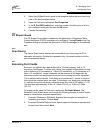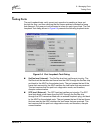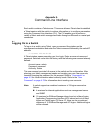
6 – Managing Ports
Configuring Ports
6-12 59048-02 A
Q
6.2.4
Changing Buffer-to-Buffer Credits
SANbox2 switches negotiate with other switches to resolve differences in the
number of port buffer credits. However, certain non-FC-SW-2-compliant switches
do not negotiate and will isolate when connected. To remedy this situation,
disconnect the switches, then reconfigure the SANbox2 E_Port to match the
number of port buffer credits on the other switch.
To change buffer-to-buffer credits to permit interoperability with non-compliant
switches, do the following:
1. Determine the number of credits per port for the non-compliant switch:
If the credits per port is equal to 12, stop here – no changes are
needed.
If the credits per port is less than 12, proceed to step 2.
If the credits per port is greater than 12, you must extend credits for the
affected SANbox2 port to increase the number of credits to match that
of the non-standard switch. Refer to ”Extending Port Credits” on
page 6-13.
Table 6-9. Port Modes
State Description
F_Port Fabric port - Supports a single public device (N_Port).
FL_Port Fabric loop port - Self discovers a single device (N_Port) or a loop of up
to 126 public devices (NL_Port).
TL_Port Translated loop port - Supports a loop of up to 124 private target devices
capable of communicating with up to 63 off-loop initiator devices. Refer to
the installation guide for your switch for more information about TL_Ports.
G_Port Generic port - Self discovers as an F_Port or an E_Port.
GL_Port Generic loop port - Self discovers as an F_Port, FL_Port, or an E_Port.
GL_Port is the default port mode. A single device on a public loop will
attempt to configure as an F_Port first, then if that fails, as an FL_Port.
Donor Donor port - Allows buffer credits to be used by another port.
Note: Changing buffer-to-buffer credits is necessary only for E_Ports that are
connected to non-FC-SW-2-compliant switches. Contact your
authorized maintenance provider for assistance in using this feature.


















